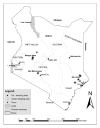Coxiella burnetii Detected in Tick Samples from Pastoral Communities in Kenya
- PMID: 30105251
- PMCID: PMC6076967
- DOI: 10.1155/2018/8158102
Coxiella burnetii Detected in Tick Samples from Pastoral Communities in Kenya
Abstract
Ticks are important disease vectors in Kenya with documented evidence of carriage of zoonotic pathogens. Coxiella burnetii is an important tick-borne pathogen that is underreported in Kenya and yet this infection likely contributes to undiagnosed febrile disease in pastoral communities. Archived human blood (278) and tick pool samples (380) collected from five pastoral communities in Kenya were screened for C. burnetii by PCR using primers targeting the transposon-like IS1111 region. All the human blood samples were negative for C. burnetii DNA. However, C. burnetii was detected in 5.53% (21/380) of the tick pools tested. Four of the twenty-one PCR positive samples were sequenced. The findings indicate that Coxiella burnetii was not present in the human blood samples tested. However, C. burnetii was detected in ticks from Mai Mahiu, Marigat, Ijara, Isiolo, and Garissa indicating a natural infection present in the tick vector that poses a risk to livestock and humans in these communities.
Figures
Similar articles
-
Coxiella burnetii serostatus in dromedary camels (Camelus dromedarius) is associated with the presence of C. burnetii DNA in attached ticks in Laikipia County, Kenya.Zoonoses Public Health. 2024 Aug;71(5):503-514. doi: 10.1111/zph.13127. Epub 2024 Apr 16. Zoonoses Public Health. 2024. PMID: 38627945
-
Coxiella burnetii in camels (Camelus dromedarius) from Algeria: Seroprevalence, molecular characterization, and ticks (Acari: Ixodidae) vectors.Acta Trop. 2020 Jun;206:105443. doi: 10.1016/j.actatropica.2020.105443. Epub 2020 Mar 13. Acta Trop. 2020. PMID: 32173315
-
Molecular survey of Coxiella burnetii in wildlife and ticks at wildlife-livestock interfaces in Kenya.Exp Appl Acarol. 2017 Jul;72(3):277-289. doi: 10.1007/s10493-017-0146-6. Epub 2017 Jun 7. Exp Appl Acarol. 2017. PMID: 28593481
-
Prevalence of Coxiella-infections in ticks - review and meta-analysis.Ticks Tick Borne Dis. 2022 May;13(3):101926. doi: 10.1016/j.ttbdis.2022.101926. Epub 2022 Feb 16. Ticks Tick Borne Dis. 2022. PMID: 35190334 Review.
-
The Importance of Ticks in Q Fever Transmission: What Has (and Has Not) Been Demonstrated?Trends Parasitol. 2015 Nov;31(11):536-552. doi: 10.1016/j.pt.2015.06.014. Epub 2015 Oct 11. Trends Parasitol. 2015. PMID: 26458781 Review.
Cited by
-
Effects of cattle on vector-borne disease risk to humans: A systematic review.PLoS Negl Trop Dis. 2023 Dec 19;17(12):e0011152. doi: 10.1371/journal.pntd.0011152. eCollection 2023 Dec. PLoS Negl Trop Dis. 2023. PMID: 38113279 Free PMC article.
-
Prioritizing smallholder animal health needs in East Africa, West Africa, and South Asia using three approaches: Literature review, expert workshops, and practitioner surveys.Prev Vet Med. 2021 Apr;189:105279. doi: 10.1016/j.prevetmed.2021.105279. Epub 2021 Jan 27. Prev Vet Med. 2021. PMID: 33581421 Free PMC article.
-
Surveillance of Vector-Borne Zoonotic Diseases in South Korea: Uncovering Novel Pathogen Carriers Among Rodents and Mites Nationwide.Transbound Emerg Dis. 2024 Nov 8;2024:5544660. doi: 10.1155/2024/5544660. eCollection 2024. Transbound Emerg Dis. 2024. PMID: 40303086 Free PMC article.
-
Tick-Borne Diseases in Sub-Saharan Africa: A Systematic Review of Pathogens, Research Focus, and Implications for Public Health.Pathogens. 2024 Aug 17;13(8):697. doi: 10.3390/pathogens13080697. Pathogens. 2024. PMID: 39204297 Free PMC article.
-
Antimicrobial resistance gene lack in tick-borne pathogenic bacteria.Sci Rep. 2023 May 20;13(1):8167. doi: 10.1038/s41598-023-35356-5. Sci Rep. 2023. PMID: 37210378 Free PMC article.
References
MeSH terms
LinkOut - more resources
Full Text Sources
Other Literature Sources


